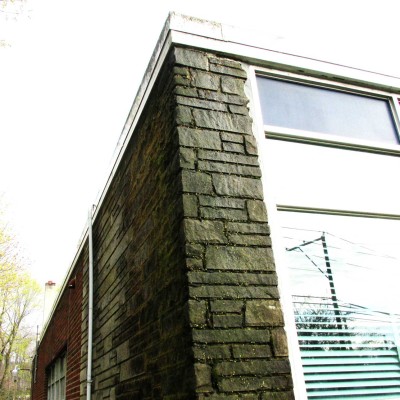Hazardous Materials Investigation from the Outside In
 Hazardous materials investigation that included water damage on the exterior corner of the building from water runoff over the lip of the roof.
Hazardous materials investigation that included water damage on the exterior corner of the building from water runoff over the lip of the roof. Preparing a building for renovations can be quite an extensive process requiring a team of experts to evaluate all the components of a structure that will be impacted by the redesign and construction. The environmental element can be very simple depending on the former use of the building and when it was constructed. If the structure was built prior to the 1970s a hazardous materials investigation will be necessary, but if the property is changing hands a Phase I Environmental Site Assessment will be performed to fulfill due diligence requirements for a property transaction. These two evaluations will help you determine how extensive the environmental component of your project will be. They help you prepare for any unsuspected environmental risks before your project begins. Being prepared will help your project move forward, but as we all know, you can’t prepare for everything.
A hazardous materials investigation includes an assessment of building materials that have health risks associated with them once the materials are disturbed, these include but are not limited to: asbestos, lead-based paint, PCB’s and mold. Mold, is a biological contaminant that presents itself when the environmental conditions are favorable, and usually should be included in this investigation. Because it “occurs” when the conditions are right and was not part of the buildings planned structure, it is easily overlooked as a hazard until it has become visible in the interior. Mold thrives in a moist environment with poor air circulation and can contaminate an area from the inside out, or in this case from the outside in. Not from a leaky roof, but from water runoff over the lip of the roof and then soaking into the exterior mortar. People are frequently surprised that brick and stone mortar structures absorb significant amounts of moisture and if there is a lot, it will penetrate to the interior wall cavities where mold growth quickly follows.
On this field day Friday, Element is conducting a hazardous material investigation which includes obvious mold contamination. Lead-based paint and asbestos containing materials (ACM) may have been at the forefront of our hazardous material investigation because of the regulatory environment surrounding these materials, but mold contamination and the structural water intrusion that allowed it to flourish quickly presented itself as the bigger problem. Since water penetrated deep into the porous stone and brick facing all the way into the walls of the interior of the building causing extensive damage, professional mold remediation will be necessary. Care must be taken when handling combinations of hazardous materials simultaneously. A simple hazardous material investigation has turned into a significant asbestos and mold abatement project that will need to be completed prior to renovation activities.



